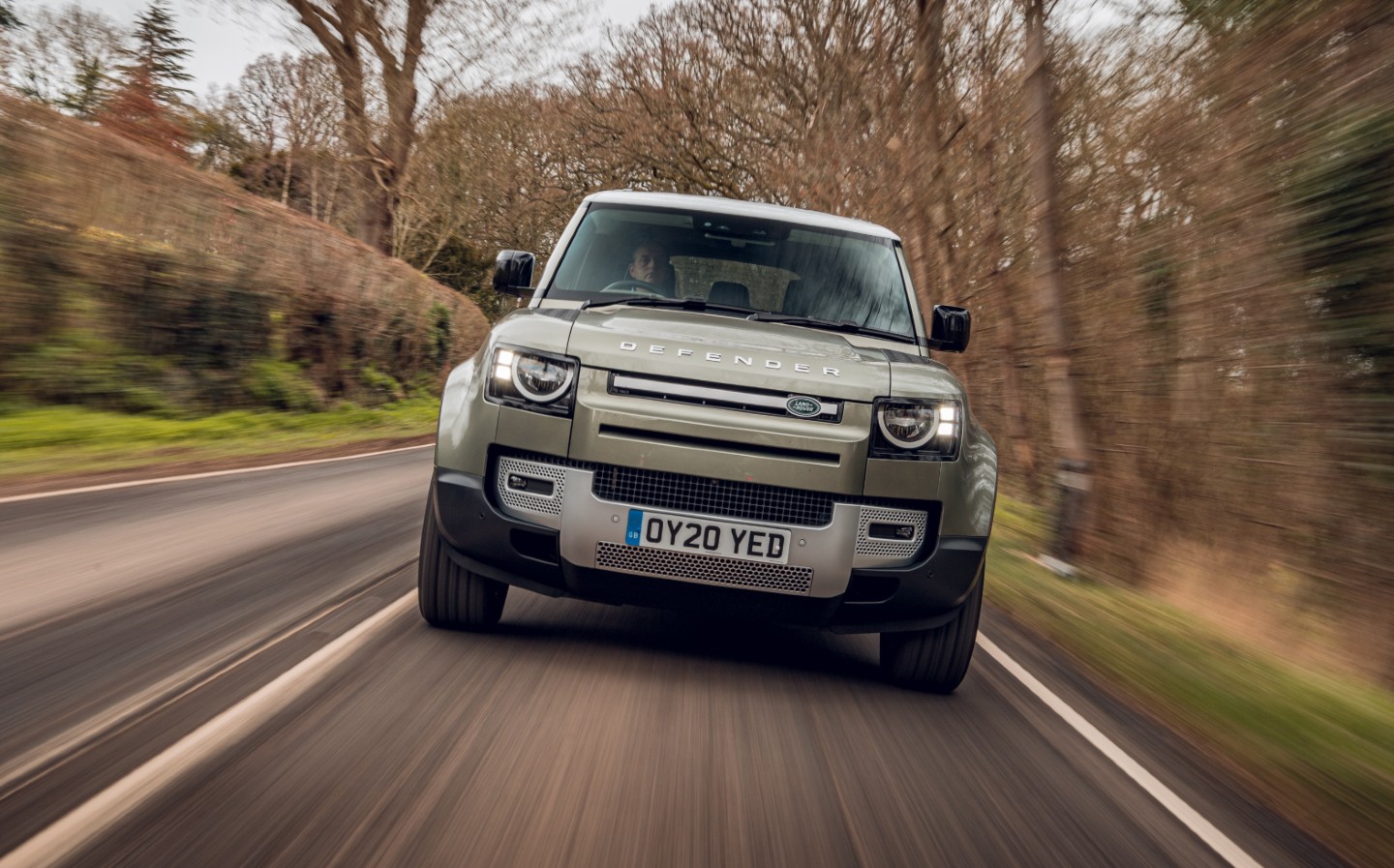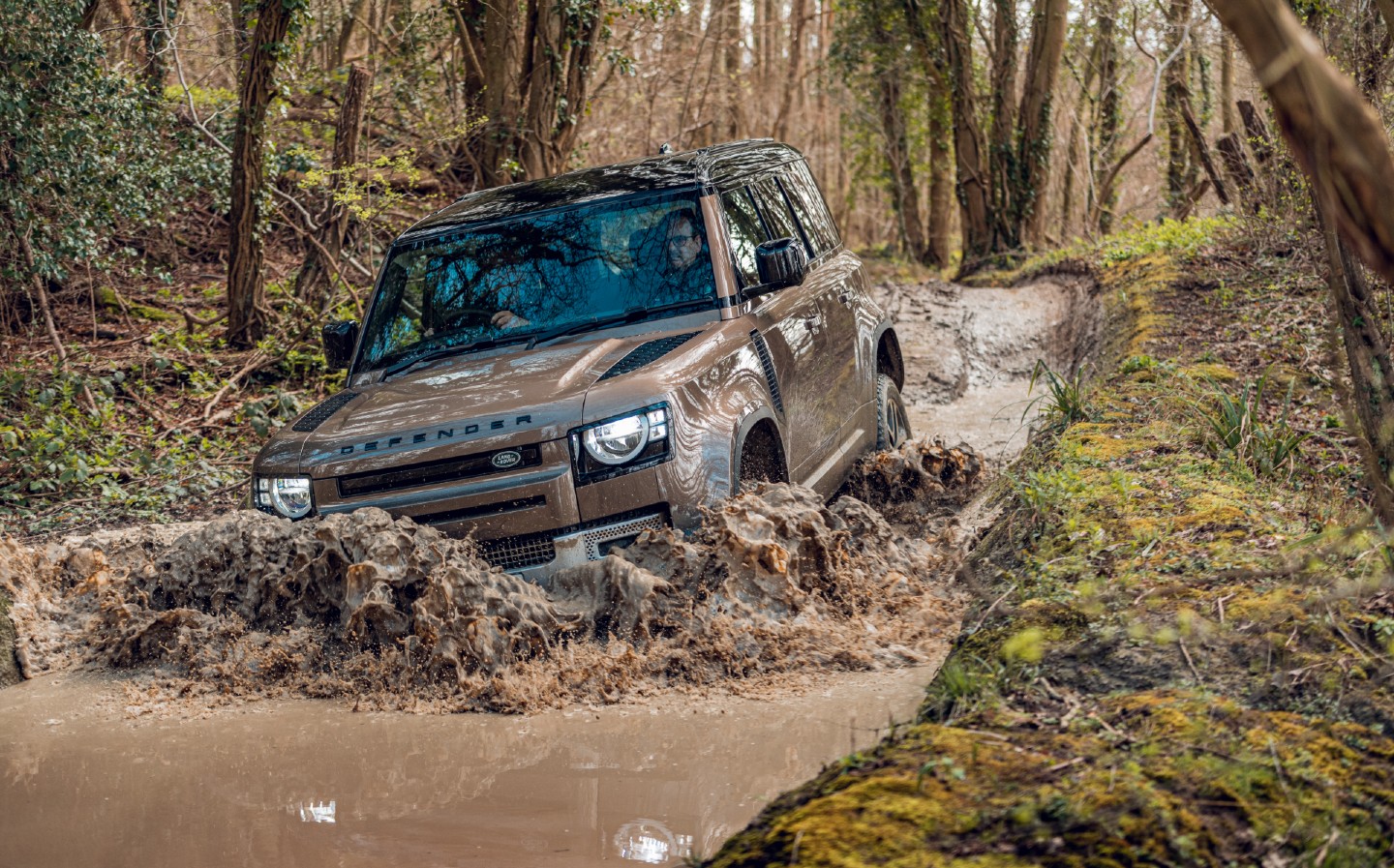2020 Land Rover Defender review
Tough mudder reinvented for the modern era
AH, THE DIFFICULT second album. Although the new Defender arrives more than seven decades after the first Land Rover was born from a sketch on the sand, and the model has been refreshed numerous times in the intervening years, those updates were mere tinkering compared with what you see in the pictures here. The 2020 model is the first ground-up reimagining of the Defender; not a single component is shared with the version it replaces.
Of course, this has not gone down well with the traditionalists, who covet the original, but due to modern safety standards and engine emission regulations (both current and upcoming), Land Rover was faced with either a complete overhaul of its original off-roader or dropping it completely. They perhaps could have gone down the route taken by Ineos, which recently launched the Grenadier – a car so close in appearance to the old Defender that Jaguar Land Rover challenged its design in court (and lost).
But the Grenadier, while enjoying the same classic design benefits of the old Defender, also suffers from a number of its problems. For one, it has twin live axles – solid beams, which are stone age technology these days – with coil springs. The new Defender, meanwhile, has sophisticated independent air suspension as standard on each corner (though coils can be fitted), allowing impressive amounts of articulation (500mm).
And the Grenadier is expected to be priced at around £40,000 when it arrives next year. The Defender 90 starts at around the same price (£40,290), while the 110 costs from £45,560 on the road. Which makes it hard for me to see the appeal of the Ineos model, other than as a two-fingered salute to Land Rover. The new Defender is also a bargain compared with the Mercedes G-class, which costs upwards of £93,000, and larger and more desirable than both the Jeep Wrangler and Suzuki Jimny.
The utilitarian look of the G-class also seems much starker now the new Defender has arrived. The Land Rover has retained a few design characteristics (the squared-off wheelarches; short overhangs; spare wheel on the boot door; the “alpine light” panels in the sides of the roof) but has been thoroughly modernised, with more sculpted lines that hint at a more sophisticated construction process than the couple-of-blokes-in-a-shed-with-a-hammer look of the old Defender.
Designer Gerry McGovern told us he wanted to capture the essence of the original Defenders while incorporating modern technology, and majored on geometric shapes (the front and rear lights; window panels; entire rear section), with a strong emphasis on horizontal lines along the side and vertical lines at the rear. This is all designer-speak, but the result, I think, is tremendous. For some it may be a bit too SUV-ish, but for me it has retained enough of the old car to be instantly recognisable as a Defender, while at the same time not looking like a throw-back, or dated.
The interior, too, retains a lot of the practicality that is absolutely essential from a Defender. Grab handles can be found at each end of the dashboard as well as directly in front of the front passenger, in the roof and in the centre console. There’s a solid aluminium beam running full width in the dash, with the word Defender neatly embossed within, and exposed screwheads and other structural elements throughout, hinting at the cars ruggedness. The floor material is rubberised and the door sills are flush to the floor, meaning yes – the new Defender can be mopped out easily.
There are five trim levels available – Defender, S, SE, HSE, Defender X and First Edition – meaning there are varying degrees of luxury, and while “grained leather” trim comes in all but the entry-level version (an idea that has had owners of old Defenders hooting with derision), it should be said that it is combined with a durable woven textile featuring “higher decitex fibres” and recycled polyester for added strength in areas subjected to the most wear.
Land Rover has also confirmed a new Hardtop model will be coming soon – a stripped back model designed for commercial use.
One of the much talked-about interior features is the central jump seat, which enables three people to sit up front in either the 90 or 110 model, meaning the three-door Defender can seat up to six while the five-door can be specified with five, six or 5+2, thanks to a pair of occasional seats in the rear.
The interior is a masterclass, really – roomy, light, rugged, practical, and, importantly, easy to use. The geometric emphasis of the exterior is mirrored inside, with the square air vents, straight horizontal lines of the dash and the straight lines of the centre console, too. There are plenty of large cubby holes, decent room for rear passengers and lots of head room. I’m 6’5” tall and can’t fit comfortably in an old Defender; so much so that I once passed on the opportunity of driving one home from a triple test, despite that fact that it would have been my first drive of the thing., and was therefore really looking forward to it – I figured the chiropractic bills wouldn’t have been worth it. The new Defender has a beautifully comfortable and well laid out cabin, and I’d be comfortable enough to drive it across continents, not just across fields.
The technology is bang up to date, too, with a central touchscreen that can run Android Auto and Apple Carplay but is actually really rather good in its default mode – lightning quick to respond to inputs and logically laid out, with sat nav, Bluetooth, DAB and all the rest. It’s actually the best infotainment system I’ve tried on any car from Jaguar Land Rover, full stop. What’s more, because everyone started stealing Range Rovers a few years back, the new Defender is fitted with ultra-wide band keyless theft technology, which the criminals haven’t been able to crack… so far.
But while the ergonomics and tech have improved immeasurably, it’s the way the new Defender drives on the road that is the true breakthrough. Road and wind noise are minimal, even at speed on the motorway. The suspension irons out the bumps in the road without being too soft and wallowy. Corners can be taken at speed, with confidence (and we were in cars shod with Goodyear Wrangler tyres, which is the intermediate option somewhere between road an off-road), and you can feel the traction control and four-wheel drive systems sending torque to each corner to reduce understeer and improve roadholding. There’s no sign of body shake and roll is kept in check. A body which, by the way, is 10 times stiffer than before, and three times stiffer than any other body-on-frame vehicle, Land Rover claims. The steering loads up nicely and is precise.
https://twitter.com/wdron/status/1289163400669405185
Seriously, the new Defender is a bloody good machine on the black stuff. The Defender has SUV levels of comfort and grip. It’s a car you can use every day for school runs then, at the weekend, fill to the rafters and drive down motorway to the coast in comfort. The only chink in its armour is a slight stuttering at very low speed, if you throw the car into a tight turn and floor the throttle – the electronic systems have a momentary panic, as if to say, “Come on, I’m not a bloody F-type.” Aside from that, it’s remarkable on road.
Of course, you’re reading this thinking, great, but it’s a let-down off-road, right? Especially compared to the old car. Wrong. So, so wrong. The new Defender proved so good on the off-road course at Eastnor Castle, along tracks that even the Discovery cannot venture down, that it was almost dull. Had I not been engrossed by the seven different Terrain Response Modes (Eco; Road; Snow & Ice; Mud Ruts; Sand; Rocks; Wading), along with the all-round camera technology that showed a 3D image of my car travelling along the narrow paths as if being followed by a drone, I may have fallen asleep.
https://twitter.com/wdron/status/1292480419078836224
The new Defender is also the first Land Rover product to feature Configurable Terrain Response, allowing further customisation of the off-road settings including adjusting slip levels for the differentials, responsiveness of the powertrain, steering weight and wheelspin amount.
I was in the D240 model, which means it had a 2-litre, four-cylinder diesel engine under the bonnet, and combined with the twin-speed transfer box, electronic trickery and permanent all-wheel, it proved more than capable dealing with everything thrown at it around Eastnor.
For anyone who needs details, the new platform provides 291mm of ground clearance, with the air suspension able to raise the body by a further 145mm when needed, while the approach and departure angles are 38 degrees and 40 degrees respectively. New Defender can climb 45-degree slopes and will wade to 900mm, while the ClearSight Ground View invisible bonnet technology shows a camera view on the touchscreen of what’s between the front wheels, which could help detect rocks under the water.
It can also tow up to 3,500kg and features semi-autonomous Advanced Tow Assist technology, with a maximum payload of 900kg and up to 300kg static roof load. And with 170 accessories – the widest range of accessories ever produced by Land Rover – there’s a huge amount of customisation options. We had Explorer pack fitted, which includes plastic wheel trim, a side carrier, cover for the spare wheel and a dust snorkel, for example. Other packs include Adventure, Country and Urban.
https://twitter.com/wdron/status/1289163400669405185
Will it go wrong a lot? Only time will tell. Can you fix it with a hammer? Probably not, no; the air suspension isn’t something you’ll be able to sort with a blow torch and gumption, either. But you’d like to think the 62,000 vehicle tests in every extreme climate known to man will have paid off. It’s a car that can take a 200mm kerb strike at up to 30mph, according to Land Rover.
You may be getting the impression that I liked this car. Well, yes, and embarrassingly I can’t really find much wrong with it. Even the fuel economy was decent: 31.9mpg during my time with the car, which included the off-road section and a good deal of on-road abuse (my “driving score” was a measly 69%, according to the trip computer, suggesting those with a lighter foot will go a lot further per tank). Economy could be even better when the hybrid models come along, and should greatly reduce the sting from the first year tax payment (CO2 is high).
I haven’t even mentioned the cavernous boot, with a button to lower the suspension and a three-pin socket… well, until the penultimate paragraph, anyway.
I suppose the Defender’s biggest fault is that it’s so good on road, as well as off, that it renders the Discovery pointless. Really – in making such a good car for every kind of terrain, has Land Rover shot itself in the foot? And the price may put off those who want a workhorse, into which you can fling some sheep or a rusty old plough. But don’t forget, there will always be secondhand versions of the old Defender out there until some more battered versions of the new model (or Hardtop) arrive on the used market. I’m willing to bet that even the hardcore haters will come around to the new Defender sooner or later; it’s just too good to dismiss forever.
2020 Land Rover Defender: official photos, price, off-road ability and on sale date
Exclusive: Mr JWW goes off-road with the all-new Land Rover Defender
James Bond stunt team provide toughest test of all for new Land Rover Defender
























